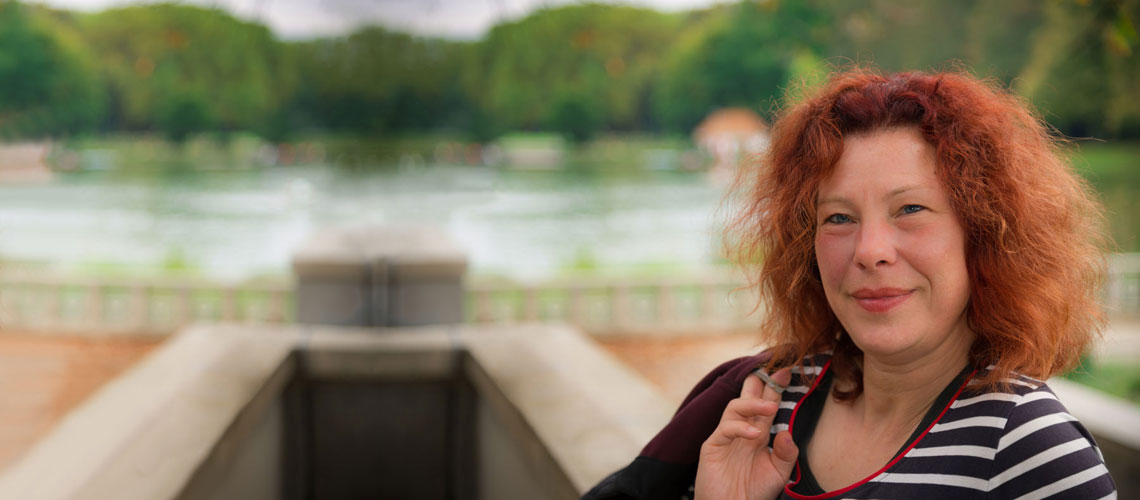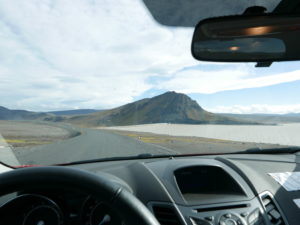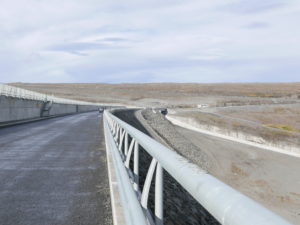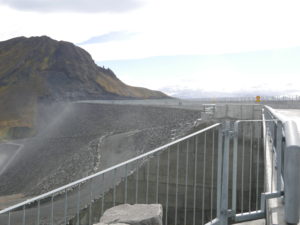Andri Snær, den Autor des Buches „Traumland“ zu treffen, war schon lange einer meiner Herzenswünsche. Also rief ich ihn an. Und durfte sofort vorbeikommen. Der Präsidentschaftskandidat aus dem Jahr 2016 empfängt mich im knisternden Plastik-Radfahrerdress und mit einem Helm unterm Arm. Hier der Teil des Interviews, in dem es um die „Grüne Energie“ geht. Einfach 1:1 abgetippt (Rechtschreibfehler bitte entschuldigen).
Andris Büro befindet sich in einem – wie er selbst es nennt – überaus hässlichen brauen Haus – am Rande der Innenstadt von Reykjavík. Er erzählt, wie es früher in Island war. Man hatte einen Energie-Berg.
We had some kind of „Power Mountain“. Like the european potato-, butter- and tomato-mountain we had this mountain of energy here. And nobody wanted it.
Das stylische Büro befindet sich in einem ehemaligen Kraftwerk im Süden Reykjavíks. Ich sehe eine Rarität: eins der wenigen isländischen Kohlekraftwerke.
We are now in an abandoned power station. This was a coal fired plant, probably the biggest coal fired power plant in Iceland, and it was a reserve power station. That is when everybody was preparing the christmas meal exactly at the same time, then we would have a power shortage in Iceland.
So they needed extra 20 megawatts on the grid into the system, so that’s when they turned this machines on. So it’s actually a christmas factory.
Im Jahr 1980 wurden die Tore für immer geschlossen.
They just walked out and locked the door. And I am part of a group that has been creating a creative centre in this building here.
Ich erzähle, dass ich auf dem Weg zu ihm am Hellisheiðarvirkjunin vorbeigekommen bin. Dem Ferrari unter den Geothermie-Kraftwerken. Hier wird die Energie für Reykjavík erzeugt heißt es. Nicht nur das, sagt Andri:
The energy is mostly going to an aluminium smelter. We maybe sacrificed a litte bit to much… The power is sold at a very low price.
I think the energy sector in Iceland has been too ambitious and too aggressive.
And ready to expand to widely. Ready to sell the power too cheaply. And do business with people I would not do business with.
Ist bzw. war er gegen die „Grüne Energie“?
I would not say, I was against energy. That would be taking things to far.
Many power facilities are very beautiful, like the one which we are here in now. Beautiful in an industrial way. And the river next to us, it has a dam, a small dam and a small power station. And there you go tot he language: Because some people would say „so you are against the dam“, but then you like this dam.
The language don’t make any difference between a dam, that was powering the first houses in Reykjavik with 2 megawatts of energy and a dam that is drowning an area that is bigger than Reykjavík. And uses 600 megawatt of energy.
You see the failure in the language: It is as if the language would not make a difference between a bicycle and a bus.
Wie komme ich denn zu dem großen umstrittenen Staudamm im Nordwesten, zum Kárahnjúkar?
From here you just point your car to the east and put it on „drive“ or first gear and then you just drive. And you drive for 8 hours on the main road and then you will come to a big lake and after you have driven 8 hours you take a left turn. And then you will see the dam. Just drive straight for 8 hours and take a left.
Wie sah es dort aus? Bevor der Damm gebaut wurde?
This used to be the most remote and untouched wilderness in Iceland. They had a series of waterfalls there, where a huge river was dropping 600 meteres.
So a river dropping 600 meters is spectacular. Because Gullfoss, one oft he most famous waterfall, this waterfall ist 30 meters high. So you can imagine a whole river dropping in steps 600 meters. I walked along these waterfalls. So I was part of a group that tried to documenta s much of that landscape before construction and before it was destroyed.
The best thing about Iceland was, that you can find things. You could still discover things. In the year 2.000. You could go somewhere, you could stop somewhere and you would stumble upon a waterfall that you had never heard of. And it would be bigger than Gullfoss, that would be the greatest tourist attraction. And it would not even have a name that would be known to most Icelanders. And that was – I believed – the greatest richness about Iceland: that not everything had been labeled or marked. You could still explore. But the politicians they said: „Oh, but why is nobody watching that waterfall? Why is nobody walking around that landscape?“ Because it was untouched! And if something is untouched, that means: People are not there. But the politicians: „That must mean it’s unpopular. That must mean, it has no economic value. Or it has no value at all.“
Warum hat man dieses tolle Gebiet im Hochland nicht für Touristen erschlossen?
Let’s make it a tourist place? We were not allowed to be creative, but the engineers, they were allowed to be creative and forcast the value of the area 40 years into the future. So it was an unequal game.
Sein Plan: Das ganze Hochland zum Nationalpark erklären!
We want to create a national park in Iceland. We want to kind of formally admit that Iceland is a paradise.
Kann sich Island so einen Luxus denn leisten? Klar, sagt Andri. Tatsächlich sei Island keinesfalls so arm wie es immer tut. Und das ganze Gerede von „Wenn wir keine Schwerindustrie haben – willst du zurück in die Torfhäuser?“ sei einfach Quatsch.
Icelanders catch 1% of all the fish in the world. And that should be enough for 300.000 people to life a rather good life. This fish could feed 20 Million people or so. It’s a huge amount of fish. 1 % of all the fish in the world, about 3% of all aluminium in the world, we have energy that could power Denmark (..) we have hot water, more tourists than most places. So we should not be on the level of sacrifice, we should be on the level of management. Careful management.
We have the full infrastructure of just a normal european city. Doctors and lawyers and marketing people and event managers. Writers and musicians. But if Iceland was a city in Europe – if we were a city of 350.000 people, somewhere between Kiel an Ahaus – it would be the biggest energy city, the biggest industrial city – because we would have more alumium production than Germany and France together – we would have 600.000 kubicmeters of fresh water per capital, we would be the biggest water provider of europe, we would be the biggest tourist destination – or at least one of he biggest tourist destinations… so Iceland has a lot.
And I think we could easily have about 2 million inhabitants without expanding any industry. Just using what we are already sipping out and producing and just living on that.





